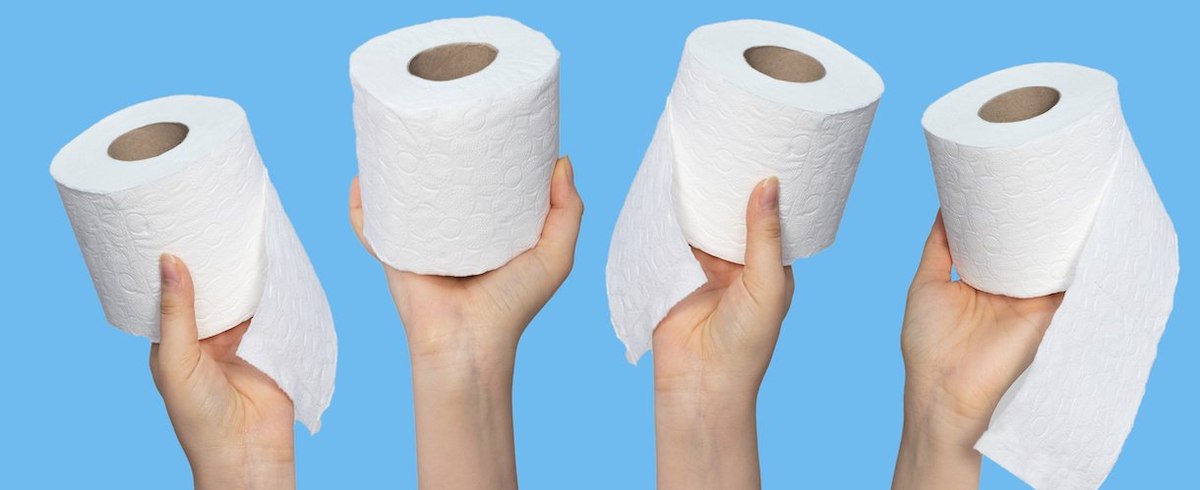Fold some toilet paper and grab a seat, because a series of recent YouGov polls asked all the bathroom-related questions you might have wondered about but been too embarrassed to ask — let alone ask 1,000 other Americans. Below, we sidestep taboos and ick factors to discover public opinion on public bathrooms; how often and why Americans use the bathroom; and routines for wiping, hand-washing, tidying up, and more. Read on if you're comfortable with a candid and occasionally messy discussion of this universal human activity.
Pottying in public: When you’re out with a group of people and need to use the bathroom, an awkward moment can occasionally arise when you're not sure whether to let people know you're headed to the toilet or to just make a break for it instead. Most people — 57% — say that in this circumstance they usually let people know they're going to the bathroom; an additional 28% say they let people know they're stepping away but do not tell them where they're going. Just one in 10 say they just get up and go without saying anything
Many Americans dread pooping in public, especially if other people are lingering outside the stall. When asked how they feel about it, most people say they feel either very (32%) or somewhat (29%) uncomfortable pooping in a public bathroom stall when other people are also in the bathroom. Women (40%) are far more likely than men (24%) to say they feel very uncomfortable.
There is a great deal of variation in the cleanliness of public bathrooms, and many people don't want to take their chances when it comes to sitting on a potentially dirty toilet. While most Americans (63%) say they usually sit when using a public toilet, half of people who do so say they first line the seat with toilet paper. One in five (21%) say they squat over public toilets and 9% say they never use them.
Public bathrooms can offer a range of amenities and most Americans would like to see them expanded. The vast majority of people (81%) support having infant-changing tables in both the men's and women's bathrooms. Most Americans (56%) also believe that feminine-hygiene products (such as tampons or pads) should be provided for free in public bathrooms. Women (60%) are more likely than men (52%) to favor this.
A longer line for the loo: Even the most patient person can find themselves distraught at the sight of a long bathroom line when they've got a full bladder. But the chances of encountering this scenario are not evenly distributed. Most Americans (71%), including both men (62%) and women (79%), believe that women's public bathrooms typically have longer lines than men's. Just 5% say men's bathrooms have longer lines and 15% say men's and women's bathrooms are equally likely to have long lines.
Another piece of evidence demonstrating that women have longer waits is the finding that women (46%) are more likely than men (39%) to say they've used a bathroom designated for the other gender when there was a line for their own.
Overall, Americans are more likely to say it's somewhat or very easy (61%) rather than somewhat or very difficult (30%) to find a free and publicly accessible bathroom in the city or town closest to them. But this varies geographically: More who live in the Northeast (44%) and West (37%) say it's difficult to find a bathroom in their local area than do people in the Midwest (24%) or South (24%).
When a free public bathroom isn't available, many Americans are willing to pay the price to potty: 44% say they've purchased something at a store or restaurant with the sole purpose of getting access to the business's bathroom. Fewer — 32% — say they've used a public bathroom that required them to pay in order to enter.
Restroom reasoning: While toilets tend to be the main attraction, public bathrooms serve a variety of purposes for their patrons. A majority of people (59%) say one reason they often enter is to wash their hands. One in five (19%) frequently go to the bathroom to check or touch up their appearance, and 44% say they do this at least on occasion (women are more likely to use the bathroom for this purpose than men). Other purposes for which people say they use public bathrooms at least on rare occasions include having a moment of quiet alone time, getting out of an awkward or uncomfortable situation, or chatting privately with friends. Very few say they often use the bathroom to use drugs (7%) or have sex (6%).
The bathroom is not a place for small talk with strangers, according to most Americans. Just 2% of people say they often have conversations with strangers when using a public bathroom; 15% say they occasionally do, 38% say they rarely do, and 45% say they never do. More men (54%) than women (36%) say they never do this.
Restroom regularity: There is wide variation in how often Americans pee and poop. Most people say they pee either 4-6 times per day (42%) or 7-9 times per day (22%); smaller shares say they pee fewer than four times per day (12%) or more than nine times (10%). When it comes to pooping, most Americans say they relieve their bowels once per day (38%) or 2-3 times per day (22%); 23% say they poop less than once a day and 4% say they do so more than three times per day.
What are Americans' nighttime potty patterns? On this, there is more fluctuation. One in five (20%) say they always get up at least once to use the bathroom at night, 20% say they often do, 31% say they sometimes do, and 30% say they rarely or never do.
Paper trail: When and how do Americans use toilet paper? Most people (87%) say they use it every time they poop and 57% say they do so every time they pee. Nearly all women (90%) say they always wipe with toilet paper after peeing, while just 22% of men say they do. Women (91%) are also somewhat more likely than men (81%) to say they always wipe with toilet paper after pooping. Wet wipes are always used after pooping by 14% of people, while just 7% use them whenever they pee.
In terms of how Americans wipe, more say they wipe in the doctor-recommended direction from front to back (51%) than from back to front (20%). Front-to-back wiping is more common among women (61%) than among men (40%).
How much toilet paper do Americans use? When pooping, most people say they use either 5-8 squares of toilet paper (31%) or between 9-12 squares (21%); 18% say they use more than 12 squares.
More people prefer to fold toilet paper into squares before wiping (44%) than prefer wadding it up into a ball (22%). While 70% of Americans say that when they're at home and use the last piece of toilet paper, they always immediately replace it with a new roll, just 6% say they rarely or never do. By 57% to 14%, Americans prefer toilet paper to be hung so that the next sheet comes over, rather than under the roll; 24% say they have no preference.
How often do Americans flush after using the bathroom? Eight in 10 (78%) say they flush the toilet every time they use it, while 15% say they only flush if there is solid waste; 7% say they rarely or never flush. More say they flush with the toilet lid up (44%) than down (27%); 22% say it varies.
Tidying up: The vast majority of Americans (82%) say they always wash their hands after pooping. Somewhat fewer — 70% — say they always wash their hands after peeing. Women are far more likely than men to say they hand-wash after pooping (90% of women vs. 74% of men) and peeing (80% vs. 60%).
When it comes to cleaning the toilet itself, most people say they personally do so multiple times per week (23%) or once per week (33%). Women (65%) are far more likely than men (47%) to say they clean their toilet on at least a weekly basis.
Most people (86%) say they keep some sort of trash can in the primary bathroom they use at home. Women are more likely than men — and especially unmarried men — to say they have a trash can in their bathroom.
Premium plumbing: Few Americans have access to a bidet (6%) or urinal (2%) in their home, but that doesn't mean they're not intrigued by either idea. About the prospect of owning a bidet, more say they're very or somewhat interested than not very or not at all interested. Fewer are very interested in owning a urinal, and more than half say they're not at all interested. Unsurprisingly, urinals draw far more interest from men than from women, though even among men, fewer than half say they're very or somewhat interested in owning a urinal.
Toilet texting: Nothing passes the time like a smartphone, and most Americans aren't shy in admitting that this applies to time spent on the toilet as well. Nearly one in three (29%) say they look at their phone often or always while using the toilet; 26% say they sometimes do and 20% say they rarely do. Just one in four (25%) say they never use their phone while on the toilet. Adults under 30 are especially likely to browse their phone while on the toilet: 40% say they often or always do.
More than half of people (56%) say they've had a phone conversation with someone while using the toilet. But bringing a phone into the bathroom also has its downsides. One in five Americans (18%) say they've dropped their phone in the toilet at some point, including 32% of people who say they always use their phone in the bathroom. Possibly because women pee sitting down or store their phones in their back pockets more often, they are more likely than men (21% vs. 15%) to say they've dropped a phone in the toilet.
There are other ways to avoid boredom in the bathroom. Some don't mind having a chat with a spouse or partner. Two-thirds of Americans in a serious relationship (65%) say they've peed in front of their significant other. Roughly half that number — 34% — say they've pooped in front of them. Men (38%) are slightly more likely than women (30%) to say they've pooped in front of their current partner.
Bathroom blunders: Toilets aren't the only place that Americans occasionally let loose. Majorities of Americans say they've peed in the shower (70%) or outdoors (73%), and 41% even say they've pooped outdoors. While they usually take a lot of crap with aplomb, toilets can be finicky under some circumstances. Nearly two-thirds of people say they've clogged their own toilet (63%), far more than say they've clogged someone else's toilet (29%) or a public toilet (27%).
Related: What foreign ways of doing things would Americans embrace?
— Linley Sanders contributed to this article
See the results for these YouGov polls
Methodology: The poll was conducted among 2,000 U.S. adult citizens on two separate surveys conducted August 4 - 7 and September 14 - 19, 2022, with each survey conducted among 1,000 U.S. adult citizens. Respondents were selected from YouGov’s opt-in panel using sample matching. A random sample (stratified by gender, age, race, education, geographic region, and voter registration) was selected from the 2019 American Community Survey. The sample was weighted according to gender, age, race, education, 2020 election turnout and presidential vote, baseline party identification, and current voter registration status. Demographic weighting targets come from the 2019 American Community Survey. Baseline party identification is the respondent’s most recent answer given prior to March 15, 2022, and is weighted to the estimated distribution at that time (33% Democratic, 28% Republican). The margin of error for the for each poll is approximately 3%.
Image: Adobe Stock (Hazal)











